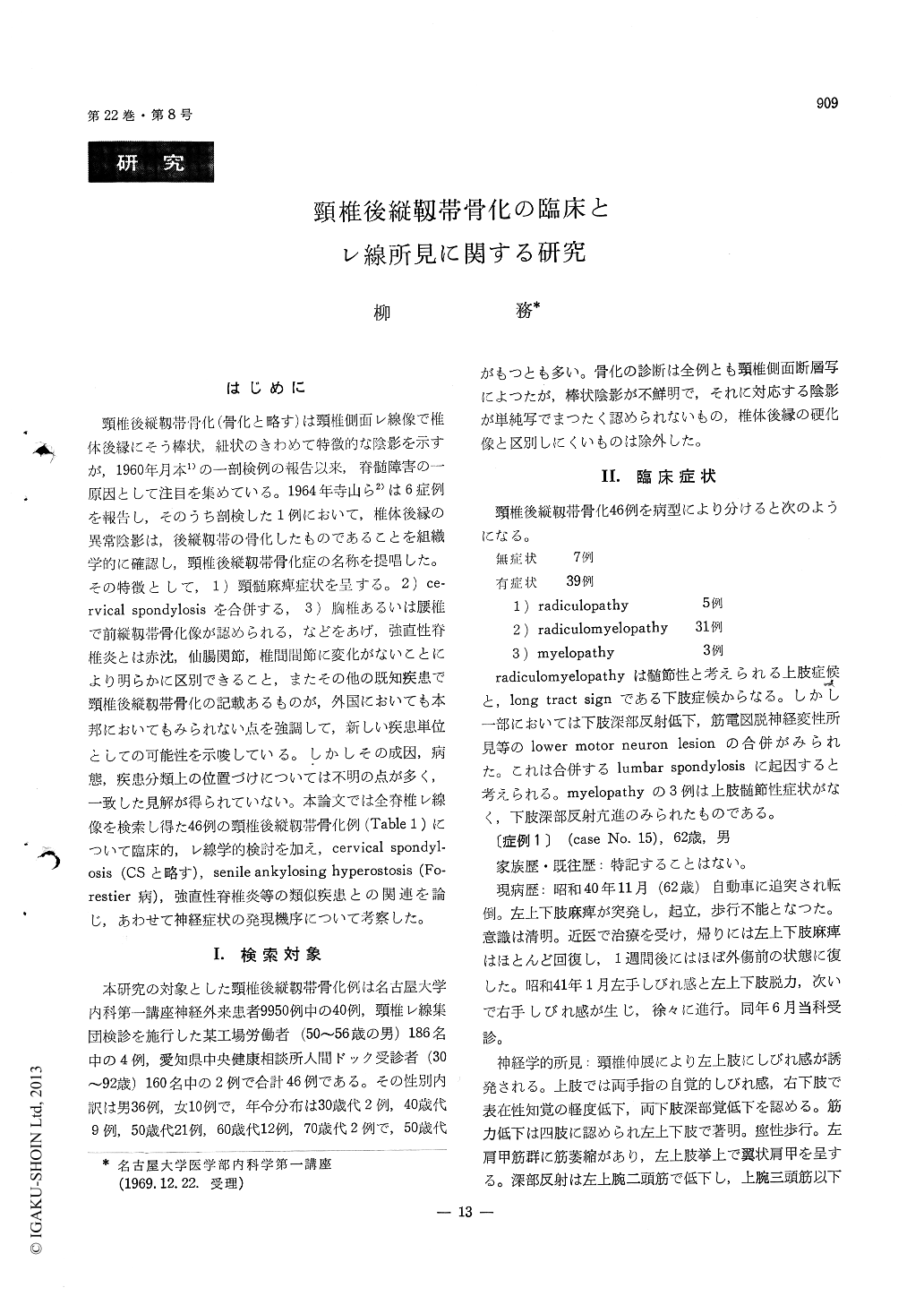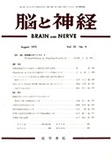Japanese
English
- 有料閲覧
- Abstract 文献概要
- 1ページ目 Look Inside
はじめに
頸椎後縦靱帯骨化(骨化と略す)は頸椎側面レ線像で椎体後縁にそう棒状,紐状のきわめて特徴的な陰影を示すが,1960年月本1)の一剖検例の報告以来,脊髄障害の—原因として注目を集めている。1964年寺山ら2)は6症例を報告し,そのうち剖検した1例において,椎体後縁の異常陰影は,後縦靱帯の骨化したものであることを組織学的に確認し,頸椎後縦靱帯骨化症の名称を提唱した。その特徴として,1)頸髄麻痺症状を呈する。2) ce—rvical spondylosisを合併する,3)胸椎あるいは腰椎で前縦靱帯骨化像が認められる,などをあげ,強直性脊椎炎とは赤沈,仙腸関節,椎間間節に変化がないことにより明らかに区別できること,またその他の既知疾患で頸椎後縦靱帯骨化の記載あるものが,外国においても本邦においてもみられない点を強調して,新しい疾患単位としての可能性を示唆している。しかしその成因,病態,疾患分類上の位置づけについては不明の点が多く,一致した見解が得られていない。本論文では全脊椎レ線像を検索し得た46例の頸椎後縦靱帯骨化例(Table 1)について臨床的,レ線学的検討を加え,cervical spondyl—os (CSと略す),senile ankylosing hyperostosis (Fo—restier病),強直性脊椎炎等の類似疾患との関連を論じ,あわせて神経症状の発現機序について考察した。
Ossification of the posterior longitudinal ligament of the cervical spine (OPLL), first reported by Tsu-kimoto in 1960, is characterized roentgenographically by the presence of a longitudinal rod-like shadow along the posterior margin of the vertebral body, and clinically by neurological manifestations result-ing from the lesion of the cervical cord and/or radix. Forty-six cases of OPLL were studied roentgeno-graphically and clinically and the following results were obtained.
1) The ages of forty-six cases ranged from 36 to 74, with the peak incidence in the six decade Thirtyseven were males and nine were females, the ratio of male to female being 4 : 1.
2) Ossification was frequently recognized at the upper cervical spines, C5, C4, C3 and C2 in the de-creasing order of incidence.
3) Neurological menifestations as result of cer-vical cord and/or radix lesion were found in 39 out of 46 cases : radiculopathy in 5, radiculomyelo-pathy in 31, and myelopathy in 3 cases. The re-maining seven cases were asymptomatic. It may be that the presence of OPLL, as well as cervical spondylosis, does not necessarily cause neurological manifestations.
4) Evidences of cervical spondylosis, such as nar-rowing of intervertebral space, posterior osteophyte and narrowing of intervertebral foramina were de-monstrated in 36 out of the 46 cases. The incidence of cervical spondylosis associated with OPLL was significantly higher in the symptomatic than in the asymptomatic cases.
5) Roentgenographic findings characteristic of OPLL, which are much more frequent than in cervical spondylosis, are ossification of anterior longitudinal ligament and bridge formation between the two adjacent vertebral bodies, the former were seen in 21 cases (46 %) and the latter in 16 (35 %) out of the 46 cases.
6) The antero-posterior diameter of the narrowest cervical spinal canal, expressed as the distance from the posterior margin of OPLL to the nearest lamina on the lateral tomogram of the cervical spine, was significantly smaller in the symptomatic than in asymptomatic group. However regarding the cord symptoms and signs, there was no correlation be-tween the clinical severity and the degree of steno-sis of spinal canal.
7) Two cases associated with ankylosing spon-dylitis and six cases with Forestier's disease were included in this series. As has been postulated, OPLL appears to be a clinical entity in some cases of this series. But it is also probable that in some in-stances OPLL could be recognized as a local man-ifestation of generalized ligamentous ossifications, such as those seen in ankylosing spondylitis or Forestier's disease.

Copyright © 1970, Igaku-Shoin Ltd. All rights reserved.


